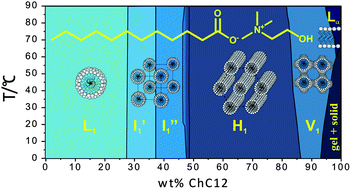Aqueous phase behaviour of choline carboxylate surfactants—exceptional variety and extent of cubic phases†
Abstract

* Corresponding authors
a
Institute of Physical and Theoretical Chemistry, University of Regensburg, Regensburg, Germany
E-mail:
werner.kunz@chemie.uni-regensburg.de
Fax: +49 941 943 4532
Tel: +49 941 943 4044
b Department of Chemical Engineering, University of Manchester, Manchester, UK
c Institute for Advanced Chemistry of Catalonia, CSIC, Barcelona, Spain
d Laboratoire Interdisciplinaire sur l'Organisation Nanométrique et Supramoléculaire CEA/IRAMIS, CEA Saclay, Gif sur Yvette, France

 Please wait while we load your content...
Something went wrong. Try again?
Please wait while we load your content...
Something went wrong. Try again?
R. Klein, G. J. T. Tiddy, E. Maurer, D. Touraud, J. Esquena, O. Tache and W. Kunz, Soft Matter, 2011, 7, 6973 DOI: 10.1039/C1SM05108C
To request permission to reproduce material from this article, please go to the Copyright Clearance Center request page.
If you are an author contributing to an RSC publication, you do not need to request permission provided correct acknowledgement is given.
If you are the author of this article, you do not need to request permission to reproduce figures and diagrams provided correct acknowledgement is given. If you want to reproduce the whole article in a third-party publication (excluding your thesis/dissertation for which permission is not required) please go to the Copyright Clearance Center request page.
Read more about how to correctly acknowledge RSC content.
 Fetching data from CrossRef.
Fetching data from CrossRef.
This may take some time to load.
Loading related content
